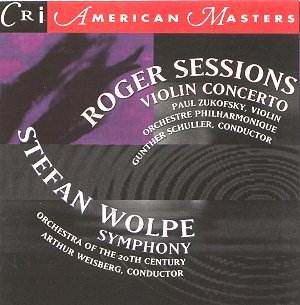Roger SESSIONS (1896-1985);
Stephan WOLPE (1902-1972)
Violin Concerto (1935) [28.53] Paul Zukofsky
(violin)
Symphony (1956) [25.53]
 Orchestre
Philharmonique/Gunther Schuller (Sessions); Orchestra of the 20th Century/Arthur
Weisburg
Orchestre
Philharmonique/Gunther Schuller (Sessions); Orchestra of the 20th Century/Arthur
Weisburg
 CRI American masters
CD676 [54.57]
CRI American masters
CD676 [54.57]
Amazon
USA

Wolpe was born in Berlin and died in New York City. In his teens he took
up music. He attended the Academy of Music in Berlin and studied composition
with Paul Juon and Franz Schreker. Later he worked with Brecht and Webern.
He came strongly under the influence of Schoenberg's music and quickly laid
down deep foundations in dissonance and atonality. Driven, like so many others,
from Germany by Nazism he came, via the then Palestine, to the USA in 1938.
Wolpe's symphony was written in 1955-6 commissioned, strangely enough, by
Rodgers and Hammerstein. Bernstein supported the score and arranged for its
premiere with the NYPO but not under his baton. It was 1964 before the premiere
happened and this was only two-thirds of the piece and it was revised for
that performance. Wolpe described it as a 'structured field of pitches'.
The relations of the various tones are disturbed and then restored: calm,
simplicity, tension and relaxation. Harold Schonberg felt that the serial
nature of the work went far beyond the second Viennese school.
Roger Sessions was, on the other hand, born in the USA (Brooklyn). He too
is a purveyor of dissonance although his earliest works are more tensely
Stravinskian than Webern-like. The violin concerto was started in 1931 and
finished in 1935. It is a dodecaphonic work in which the role of the violin's
solo line is emphasised by removing the violins from the accompanying orchestra.
The work had to wait until 1940 for its premiere with orchestra however its
second life began with a performance by Tossy Spivakovsky in New York with
the Phil conducted by Bernstein (1964). The present excellent recording was
made in 1974 being close-up and very solid. If you like the Schoenberg Concerto
or the Frankel you will have no trouble with appreciating this work. It is
hazily Semitic, extremely romantic, occasionally Bachian, brilliantly spick
and span, a ferment of melody - thorny, yes but unmistakably melodic.
The Wolpe is more difficult
by several orders of magnitude. In the Sessions
there are lines and continuity. In this
symphony there is discontinuity and fragmentation,
rowdy and distrait. I found Wolpe's battering
language of ideas that smash against each
other and never quite meet an obstacle to
appreciation. The recording is clearly older
than the Sessions, is in mono and has a
steady flow of tape hiss.
Good documentation and design but nowhere do you find any details about the
exact recording dates.
The disc scores well for the Sessions but the Wolpe remains a closed book
for this listener.
Rob Barnett

